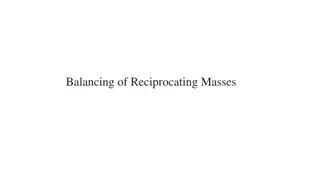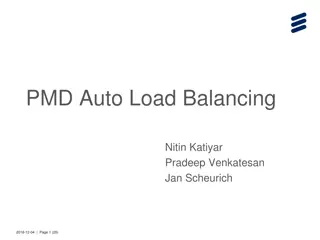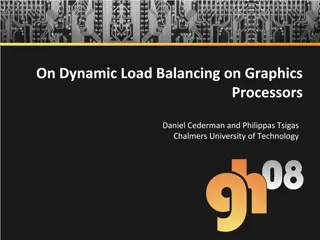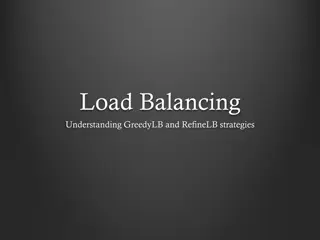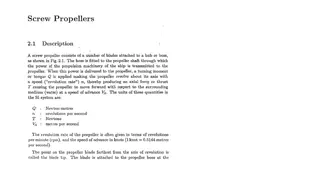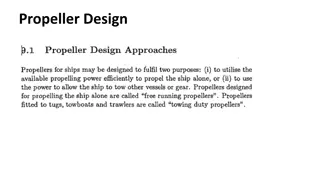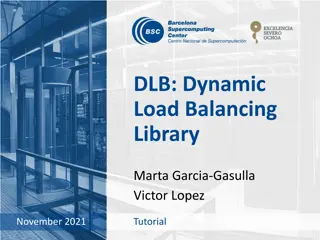Understanding Dynamic Propeller Balancing with ProBalancer Sport
Explore the importance of dynamic propeller balancing using the Model 1015 ProBalancer Sport. Learn about vibration basics, balancing benefits, and fundamentals of using the ProBalancer Sport for propeller balancing. Discover how vibration affects aircraft components, leading to issues like engine failure and passenger discomfort.
Download Presentation

Please find below an Image/Link to download the presentation.
The content on the website is provided AS IS for your information and personal use only. It may not be sold, licensed, or shared on other websites without obtaining consent from the author. Download presentation by click this link. If you encounter any issues during the download, it is possible that the publisher has removed the file from their server.
E N D
Presentation Transcript
Dynamic Propeller Balancing Using the Model 1015 ProBalancer Sport Product Support ACES Systems/TEC Aviation Division
Goals for This Training Understand Basics of Vibration Understand the Benefits of Balancing Understand the Fundamentals for using the ProBalancer Sport for Dynamic Propeller Balancing
Overview The Basics of Vibration Definition Why it happens How the ProBalancer Sport measures it How we correct it
The Basics of Vibration Definition Vibration is defined as: mechanical oscillation about an equilibrium point. For the purpose of Propeller Balance, vibration can be described as: the unwanted, unproductive, cyclic oscillation of the propeller and engine assembly about its rotational axis.
The Basics of Vibration Remember All noise and/or vibration is not generated by an imbalance in the propeller. To verify the vibration source, a vibration survey should be conducted and manufacturers limitations adhered to.
The Basics of Vibration Why Does It Happen? When the weight of a rotating propeller and engine assembly is not equally distributed, the dominant or heavy point attempts to continue moving in a straight line. The resulting force attempts to pull the assembly outside its rotational axis. The assembly then orbits what would be the normal center of rotation, causing vibration.
The Basics of Vibration Vibration-Related Complaints Cracked exhaust stacks and sheet metal Higher than normal occurrence of engine and prop oil leaks and light bulb failures Physical movement of airframe (buzz in the seat, yoke, rudder pedals) Malfunctioning or failed avionics Passenger complaints of noise in the cabin
The Basics of Vibration Examples of the Effects of Vibration Vibration excites natural frequencies in other components throughout the airframe and engine assemblies. The expended energy from vibration causes wear of components, reduced performance, and passenger discomfort.
The Basics of Vibration How the ProBalancer Sport Measures Vibration Sensor Type Sensor Engineering Unit Characteristics of the Sensor Sensor Specifications Sensor Mounting
The Basics of Vibration How It Is Measured The vibration sensor generates a small voltage when the mass compresses the piezoelectric element. That voltage is proportional to the force being exerted on the element.
The Basics of Vibration How It Is Measured Sensor Type The ProBalancer Sport uses an accelerometer to measures the rate of change of velocity with time. Engineering Unit gs (equivalent gravities) - acceleration
The Basics of Vibration How It Is Measured Sensor Characteristics Accelerometers Measure Acceleration Typically Reported in g s More Sensitive to Higher Frequencies Directly Related to Force Caused by Unbalance Used in Balancing (after conversion to velocity or displacement)
The Basics of Vibration How We Correct It Improve manufacturing methods Remove and replace defective components Static Balance Static Balance + Dynamic Balance
Overview Understanding the Benefits of Balancing The negative effects of vibration How balancing effects service life and economy of operation
The Benefits of Balancing Reduces: Noise Vibration Airframe damage Avionics damage Fatigue and stress on passengers Increases: Economy of operation Service life of airframe and components Comfort
Overview Fundamentals for using the ProBalancer Sport for Dynamic Propeller Balancing When to balance Required equipment Setting up the equipment Data collection and processing The balancing process Avoiding the pitfalls
Fundamentals of Balancing When to Balance Danger - Remove and Static 1.25 IPS Very Rough Static balance recommended 1.00 IPS Rough Dynamic balance recommended .50 IPS Slightly Rough - Balance for ride Fair - Maximum after Dynamic .25 IPS .15 IPS .07 IPS 0 IPS Good - Not felt by occupants
Fundamentals of Balancing When to Balance An example of a manufacturer s balancing recommendation. McCauley Service Letter 1989-4D Revised July 20, 2001 Endorses dynamic balance on propellers installed on piston and turbine powered aircraft. Over 0.8 IPS initial reading - list of corrective actions.
Fundamentals of Balancing When to Balance An example of a manufacturer s balancing recommendation Hartzell Service Letter HC-SL-61-165 Revised December 7, 1995 Warns that all propellers need to be inspected for abnormal grease leakage or vibration. Perform Troubleshooting and evaluate possible sources of vibration IAW engine/airframe mfr. instructions.
Fundamentals of Balancing Equipment Required A device to collect vibration and phase data. A phase angle /speed sensing device A vibration sensing device Balance weights and hand tools.
Fundamentals of Balancing Equipment Required Approved references Airframe manual Propeller Manual Engine manual (in some cases) FAA-approved Guide to Propeller Balancing
Fundamentals of Balancing Equipment Required Make sure the approval letter is attached to the Guide and references the material being used (document number, date, revision, and change numbers if applicable.)
Fundamentals of Balancing Equipment Required AC20-37E Chapter 3 Paragraph 300.C.2.(d) When approved aircraft or propeller manufacturer s procedures are not available, there are other acceptable dynamic propeller balancing procedures. These include, but are not limited to ACES Publication No. 100-OM-01, entitled ACES Systems Guide to Propeller Balancing . Dynamic balancing of propellers using FAA-approved or - accepted dynamic propeller balancing procedures is not considered a major propeller repair unless the propeller static balance weights are altered or when using ACES type documents on propeller installations of 500 horsepower or more. (emphasis added)
Fundamentals of Balancing BEFORE Setting Up the Equipment Propeller Inspection Prior to Balancing Ensure all Airworthiness Directives have been accomplished for the propeller you are going to balance. Determine if there is a balancing procedure published by the airframe, engine or propeller manufacturer; if there is, it will take precedence.
Fundamentals of Balancing BEFORE Setting Up the Equipment Inspect the propeller blades for damage, nicks etc. refer to FAA Advisory Circular 20-37E which outlines care of metal propellers, and to applicable propeller manufacturers maintenance requirements. If balancing composite propeller blades, refer to the propeller manufacturer's procedures for repair of the propeller. Inspect propeller assembly for proper installation and security.
Fundamentals of Balancing BEFORE Setting Up the Equipment Perform a visual inspection of the spinner and spinner bulkhead for cracks, stop drills and welding. Mass trim weights MUST NOT be attached to a part with any of these conditions. To prevent an excessive number of weights from being attached to the spinner, remove any mass trim weights attached from previous dynamic balance jobs. Static balance weight attached to the propeller hub by a certified propeller shop MUST NOT be removed.
Fundamentals of Balancing BEFORE Setting Up the Equipment Inspect your sensor and its attached cable for obvious damage, such as, chips, pinches, or cuts in the plastic on the cable, and dints or scratches on the sensor, etcetera. Inspect your tachometer and its attached cable for obvious damage, such as, chips, pinches, or cuts in the plastic on the cable, scratches on the tachometer lens, etcetera. Ensure the batteries in your analyzer have a sufficient charge to complete the balance job.
Fundamentals of Balancing Setting Up the Equipment Always attach the vibration sensor as near as possible to the forward most point of the engine and as close to inline with the engine bearing as possible. The base of the sensor should always point to the center of the prop shaft. The vibration sensor should not be in line with a cylinder and should be positioned at 12:00 whenever possible.
Fundamentals of Balancing Setting Up the Equipment Attach the Phototach between 12 and 18 inches from the surface of the target blade and not perpendicular (90 degrees) to the surface of the blade. A 5 degree offset is best. The reflective tape should be a 2 inch long piece of 3M brand 7610, and not less than 1 inch wide. It should be installed no more than 14 inches out the prop blade from the center of the prop shaft.
Fundamentals of Balancing Setting Up the Equipment Cables should be routed away from rotating and high temp components. Secure with wire ties or tape to prevent excessive movement and possible damage. Do not close windows or doors on the cables as this may pinch or cut them. Make sure connections at the analyzer are secure.
Fundamentals of Balancing Setting Up the Equipment
Fundamentals of Balancing Data Collection & Processing The vibration sensor is installed on the engine as near the front bearing as possible. The Phototach is mounted on the cowling, behind the propeller. The reflective tape is applied to the back side of the target propeller blade in line with the Phototach beam. The mass is the theoretical heavy spot in the propeller, and is located by correlating the bump from the vibration sensor and the amount of time that has passed since the Phototach signaled the passing of the reflective tape.
Fundamentals of Balancing Data Collection & Processing The Reflective tape triggers a response as it passes the Phototach, which then sends an electrical signal to the analyzer. As the heavy spot on the propeller passes the vibration sensor, the sensor generates an electrical pulse and sends it to the analyzer.
Fundamentals of Balancing Data Collection & Processing In this illustration, the vibration sensor and Phototach beam are co- located at the 12:00 or 0 degree position. Rotation is clock-wise from the viewers position. This is our starting point, elapsed time = 0
Fundamentals of Balancing Data Collection & Processing The speed is 1 RPM. Fifteen seconds (90 degrees) of travel has occurred. In this sequence, the reflective tape has just entered the Phototach beam to trigger the tach event. Elapsed time = 15 seconds.
Fundamentals of Balancing Data Collection & Processing In this sequence, the mass (heavy spot) is passing the accelerometer position, 15 seconds (90 degrees) after the tape passed the Phototach beam. Elapsed time = 30 seconds (180 degrees of travel).
Fundamentals of Balancing Data Collection & Processing The tape and mass have both passed the 0 degree location. The unit now waits for the exact sequence to repeat for averaging. Elapsed time = 45 seconds (270 degrees of travel)
Fundamentals of Balancing Data Collection & Processing
Fundamentals of Balancing Data Collection & Processing The process is repeated while the analyzer averages out errors caused by momentary vibration events outside the running average.
Fundamentals of Balancing Data Collection & Processing When sufficient data has been collected, the process is stopped by the analyzer and the averaged data displayed on screen. Notice that you have the option to Retake the data if desired.
Fundamentals of Balancing Data Collection & Processing The analyzer will prompt you to shut down the engine. When less than 50 RPM are recognized by the analyzer, it will progress to the solution screen.
Fundamentals of Balancing Data Collection & Processing A solution is then provided by the analyzer based on a temporarily stored influence coefficient or a calculated test weight. If required, the process is then repeated for refinement of the solution. Notice you have the option to split the weights between two angles if needed.
Fundamentals of Balancing The Balancing Process With the equipment installed and all previously installed trim weights removed, head the airplane into the wind (10 KTS maximum) and begin the data collection.
Fundamentals of Balancing The Balancing Process The analyzer will show a screen instructing you to warm the engine and advance your RPM to the designated balancing RPM.
Fundamentals of Balancing The Balancing Process The analyzer will collect and average data until a sufficient amount of data samples have been collected. This should take between ten and thirty seconds under ideal conditions.
Fundamentals of Balancing The Balancing Process When the sufficient data has need collected, the Review screen shows the averaged amplitude and the phase angle of the out of balance condition.
Fundamentals of Balancing The Balancing Process The analyzer will prompt you to shut down. When a RPM reading of less than 50 RPM is indicated the analyzer will progress.
Fundamentals of Balancing The Balancing Process After the analyzer detects the engines are shut down, it will suggest a balance solution. If you require a two hole solution select 1 for yes.
Fundamentals of Balancing The Balancing Process If you split the weights, the analyzer will ask you for the angles of the two available holes. Enter the angles and press go.
Fundamentals of Balancing The Balancing Process The analyzer screen will display its suggestion and ask you for the actual angle and weights you installed. This screen will repeat for each hole location, if you chose to split the weight.





